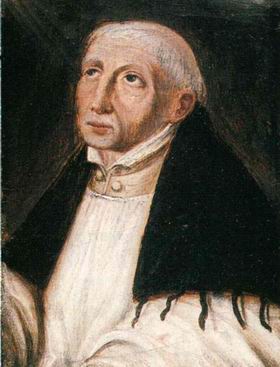Related Research Articles
The 1290s was a decade of the Julian Calendar which began on January 1, 1290, and ended on December 31, 1299.

Year 1292 (MCCXCII) was a leap year starting on Tuesday of the Julian calendar.

Year 1291 (MCCXCI) was a common year starting on Monday of the Julian calendar.

Year 1290 (MCCXC) was a common year starting on Sunday of the Julian calendar.

Year 1245 (MCCXLV) was a common year starting on Sunday of the Julian calendar.

Year 1253 (MCCLIII) was a common year starting on Wednesday of the Julian calendar.

Year 1289 (MCCLXXXIX) was a common year starting on Saturday of the Julian calendar.

Giovanni da Pian del CarpineOFM was a medieval Italian diplomat, Catholic archbishop, explorer and one of the first Europeans to enter the court of the Great Khan of the Mongol Empire. He was the author of the earliest important Western account of northern and Central Asia, Eastern Europe, and other regions of the Mongol dominion. He served as the Primate of Serbia, based in Antivari, from 1247 to 1252.
Henry of Ghent, also known as Henricus de Gandavo and Henricus Gandavensis, was a scholastic philosopher who acquired the nickname of Doctor Solemnis.

Qalāwūn aṣ-Ṣāliḥī was the seventh Turkic Bahri Mamluk sultan of Egypt; he ruled from 1279 to 1290. He was called al-Manṣūr Qalāwūn. After having risen in power in the Mamluk court and elite circles, Qalawun eventually held the title of "the victorious king" and gained de facto authority over the sultanate. He is the founder of the Qalawunid dynasty that ruled Egypt for over a century.

John of Ruusbroec or Jan van Ruusbroec, sometimes modernized Ruysbroeck, was an Augustinian canon and one of the most important of the medieval mystics of the Low Countries. Some of his main literary works include The Kingdom of the Divine Lovers, The Twelve Beguines, The Spiritual Espousals, A Mirror of Eternal Blessedness, The Little Book of Enlightenment, and The Sparkling Stone. Some of his letters also survive, as well as several short sayings. He wrote in the Dutch vernacular, the language of the common people of the Low Countries, rather than in Latin, the language of the Catholic Church liturgy and official texts, in order to reach a wider audience.

The Bahri Mamluks, sometimes referred to as the Bahri dynasty, were the rulers of the Mamluk Sultanate of Egypt from 1250 to 1382, following the Ayyubid dynasty. The members of the Mamluk ruling class were purchased as slaves (mamluks) and manumitted, with the most powerful among them taking the role of sultan in Cairo. While several Bahri Mamluk sultans tried to establish hereditary dynasties through their sons, these attempts were ultimately unsuccessful, with the role of sultan often passing on to another powerful Mamluk.
William of Rubruck or Guillaume de Rubrouck was a Flemish Franciscan missionary and explorer.

Al-Malik Al-Ashraf Salāh ad-Dīn Khalil ibn Qalawūn was the eighth Turkic Bahri Mamluk sultan, succeeding his father Qalawun. He served from 12 November 1290 until his assassination in December 1293. He was well known for conquering the last of the Crusader states in Palestine after the siege of Acre in 1291. While walking with a friend, Khalil was attacked and assassinated by Baydara and his followers, who was then killed under the orders of Kitbugha.

The Battle of Fariskur was the last major battle of the Seventh Crusade. The battle was fought on 6 April 1250, between the Crusaders led by King Louis IX of France and Egyptian forces led by Turanshah of the Ayyubid dynasty.
Ystoria Mongalorum is a report, compiled by Giovanni da Pian del Carpine, of his trip to the Mongol Empire. Written in the 1240s, it is the oldest European account of the Mongols. Giovanni was the first European to try to chronicle Mongol history.

Kitbugha, royal name: al-Malik al-Adil Zayn-ad-Din Kitbugha Ben Abd-Allah al-Mansuri al-Turki al-Mughli; Arabic: الملك العادل زين الدين كتبغا بن عبد الله المنصورى التركى المغلى) was the 10th Mamluk sultan of Egypt from December 1294 to November 1296.

Isabel de Forz was the eldest daughter of Baldwin de Redvers, 6th Earl of Devon (1217–1245). On the death of her brother Baldwin de Redvers, 7th Earl of Devon, in 1262, without children, she inherited suo jure the earldom and also the feudal barony of Plympton in Devon, and the lordship of the Isle of Wight. After the early death of her husband and her brother, before she was thirty years old, she inherited their estates and became one of the richest women in England, living mainly in Carisbrooke Castle on the Isle of Wight, which she held from the king as tenant-in-chief.
An orda or horde was a historical sociopolitical and military structure found on the Eurasian Steppe, usually associated with the Turkic and Mongol peoples. This form of entity can be seen as the regional equivalent of a clan or a tribe. Some successful ordas gave rise to khanates.

The feudal barony of Plympton was a large feudal barony in the county of Devon, England, whose caput was Plympton Castle and manor, Plympton. It was one of eight feudal baronies in Devonshire which existed during the medieval era. It included the so-called Honour of Christchurch in Hampshire, which was not however technically a barony. The de Redvers family, first holders of the barony, were also Lords of the Isle of Wight, which lordship was not inherited by the Courtenays, as was the barony of Plympton, as it had been sold to the king by the last in the line Isabel de Redvers, 8th Countess of Devon (1237–1293).
References
- ↑ Rabbat, Nasser O. (1995). The Citadel of Cairo: A New Interpretation of Royal Mameluk Architecture. Leiden, New York, Köln: BRILL. p. 181. ISBN 9789004101241.
- ↑ Hattori, J. (April 4, 1878). "Destructive Earthquakes of Japan". The Japan Mail: A fortnightly summary of intelligence from Japan, for transmission to Europe and the United States, via Suez and San Francisco. p. 178. Retrieved February 24, 2019.
- ↑ Nagayama, Kōkan (1997) [1995]. The Connoisseur's Book of Japanese Swords. Tokyo, New York, London: Kodansha International. p. 164. ISBN 9784770020710.
- ↑ Minahan, James (2012). Ethnic Groups of South Asia and the Pacific: An Encyclopedia. Santa Barbara, CA, Denver, CO, Oxford: ABC-CLIO. p. 109. ISBN 9781598846591.
- ↑ Ooi, Keat Gin (2004). Southeast Asia: A Historical Encyclopedia, from Angkor Wat to East Timor. Santa Barbara, CA, Denver, CO, Oxford: ABC-CLIO. pp. 822–824. ISBN 9781576077702.
- ↑ Goss, Glenda Dawn (2009). Sibelius: A Composer's Life and the Awakening of Finland. Chicago, London: University of Chicago Press. p. 152. ISBN 9780226304793.
- ↑ Vyborg Castle, Vyborg, Russia – Spotting History
- ↑ Pugh Rupp, Teresa (2008). ""If You Want Peace, Work for Justice": Dino Compagni's Cronica and the Ordinances of Justice". In Peterson, David S.; Bornstein, Daniel E. (eds.). Florence and Beyond: Culture, Society and Politics in Renaissance Italy : Essays in Honour of John M. Najemy. Toronto: Centre for Reformation and Renaissance Studies. p. 323. ISBN 9780772720382.
- ↑ Adams, William Henry Davenport (1856). The History, Topography, and Antiquities of the Isle of Wight. Described and Illustrated. [With Plates and a Map.]. London: Smith, Elder & Company. pp. 18–19.
- ↑ Spinozzi, Paola (2009). "Journeying Through Translation: Dante among the Victorians, Dante Gabriel Rossetti in Medieval Italy". In Orestano, Francesca; Frigerio, Francesca (eds.). Strange Sisters: Literature and Aesthetics in the Nineteenth Century. Oxford, Bern: Peter Lang. p. 77. ISBN 9783039118403.
- ↑ Rashdall, Hastings (2010) [1895]. The Universities of Europe in the Middle Ages: Volume 2, Part 1, Italy, Spain, France, Germany, Scotland, Etc. Vol. 2. Cambridge, New York: Cambridge University Press. p. 99. ISBN 9781108018111.
- ↑ Barsoum, Ephrem (2008). History of the Za'faran Monastery. Translated by Matti Moosa. Gorgias Press. p. 48.
- ↑ Rogers, Eugene F. Jr. (2009). "John Ruusbroec, from The Spiritual Espousals". The Holy Spirit: Classic and Contemporary Readings. Chicester and Singapore: John Wiley & Sons. p. 272. ISBN 9781405136235.
- ↑ Hammond, Peter; Cokayne, George Edward (1998). The complete peerage, or a history of the House of Lords and all its members from the earliest times by G.E.C., revised and much enlarged : addenda & corrigenda. Vol. XIV. Sutton. ISBN 9780750901543.
- ↑ Byrne, Vincent (2003). The Hidden Annals: A Thousand Years of the Kingdom of Connaught 366-1385. Universal-Publishers. ISBN 9781581125689.
- ↑ Wood, Cindy (2016). Studying Late Medieval History: A Thematic Approach. London and New York: Routledge. p. 58. ISBN 9781317211204.
- ↑ Nolan, Cathal J. (2006). The Age of Wars of Religion, 1000-1650: An Encyclopedia of Global Warfare and Civilization. Vol. 2. Westport, CN and London: Greenwood Publishing Group. p. 893. ISBN 9780313337345.
- ↑ Browning, Charles Henry (1998) [1883]. "Pedigree LX". Americans of Royal Descent: Collection of Genealogies Showing the Lineal Descent from Kings of Some American Families. Reproduced from Recognized Authorative Genealogical Works, From Printed Family Histories, and Verified Information Supplied in Manuscript Pedigrees (Seventh ed.). Baltimore, MD: Genealogical Publishing Com. p. 261. ISBN 9780806300542.
- ↑ Kanarfogel, Ephraim (2000). Peering Through the Lattices: Mystical, Magical, and Pietistic Dimensions in the Tosafist Period. Detroit, MI: Wayne State University Press. p. 221. ISBN 9780814325315.
- ↑ Stone, M. W. F. (2003). "Henry of Ghent on Freedom and Human Action". In Decorte, Jos; Guldentops, Guy; Steel, Carlos G. (eds.). Henry of Ghent and the Transformation of Scholastic Thought: Studies in Memory of Jos Decorte. Leuven, Belgium: Leuven University Press. p. 201. ISBN 9789058673299.
- ↑ Legg, Katrina (2004). Bolton Priory: Its Patrons and Benefactors 1120-1293. Borthwick Papers. Vol. 106. York: Borthwick Publications. p. 11. ISBN 9781904497134.
- ↑ Haag, Michael (2012). The Tragedy of the Templars: The Rise and Fall of the Crusader States . Suffolk: Profile. pp. 241. ISBN 9781847658548.
1293 Al-Ashraf Khalil.
- ↑ Montpéreux, Frédéric Dubois de (1839). Voyage autour du Caucase, chez les Tcherkesses et les Abkhases, en Colchide, en Géorgie, en Arménie et en Crimée (in French). Vol. II. Paris: Librairie de Gide. p. 164.
- ↑ Ruysbroeck, Willem van; Pian de Carpine, John of (1998) [1900]. The Journey of William of Rubruck to the Eastern Parts of the World, 1253-55: As Narrated by Himself with Two Accounts of the Earlier Journey of John of Pian de Carpine. Translated by Woodville Rockhill, William. New Delhi, Madras: Asian Educational Services. ISBN 9788120613386.